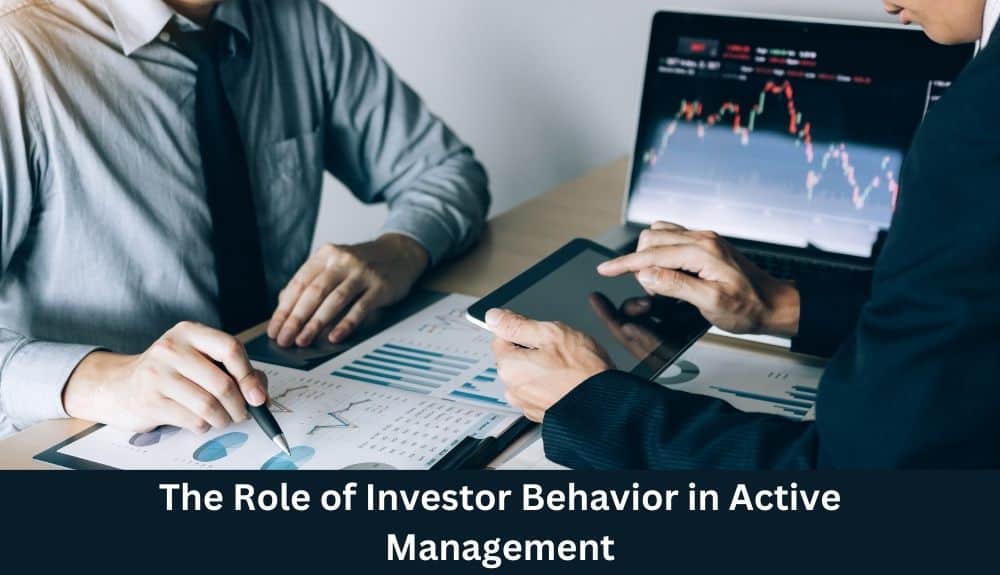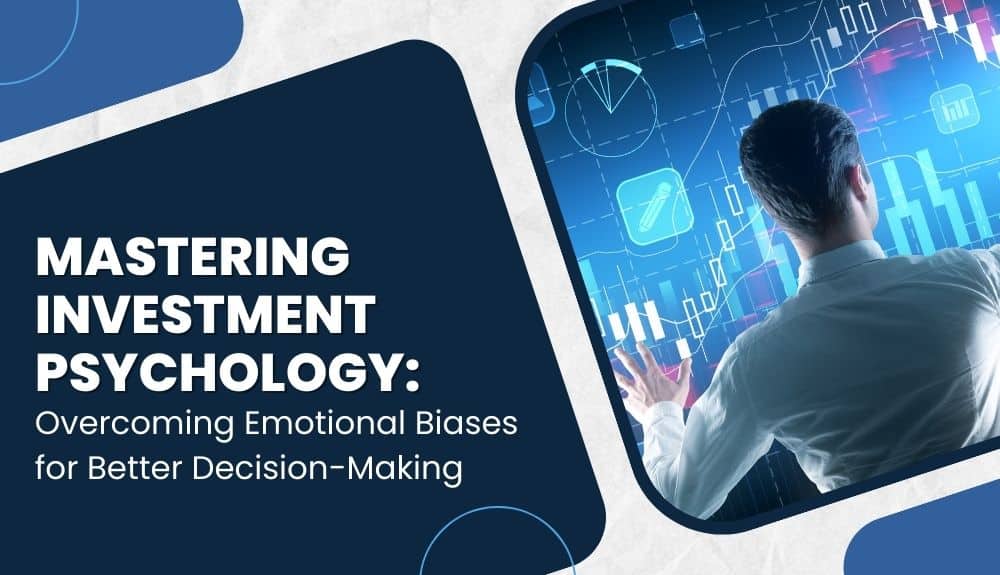Have you ever found yourself hesitating to make an investment decision, swayed by your emotions rather than rational analysis? In the unpredictable waters of the financial markets, mastering investment psychology is key to navigating the undercurrents of emotional bias for successful trading outcomes.
Emotional biases can cloud judgment, leading to impulsive actions and significant losses. However, by understanding the psychological challenges that influence decision-making, investors can develop a balanced approach that enhances their trading strategies. This blog delves deep into the impact of emotions on investment decisions, offering insights and techniques to overcome biases and improve emotional resilience.
Explore the realm of trading psychology, risk management, and the dynamics of the financial markets to discover how emotional intelligence plays a crucial role in achieving long-term success as a smart prop trader. Learn how to leverage your emotions, not be driven by them, to make informed investment decisions and elevate your trading experience to new heights.
Introduction to Investment Psychology
Investment psychology plays a pivotal role in the decision-making process and outcomes of investors. It involves understanding and managing the impact of emotional biases on investment decisions in the dynamic realm of the financial markets. Emotional biases, such as loss aversion and overconfidence, can significantly influence investment choices and potentially lead to suboptimal outcomes.
When investors face financial losses or gains, their emotional reactions can cloud their judgment and hinder their ability to make rational decisions. The fear of loss often drives investors to sell prematurely, while excessive confidence can lead to taking unnecessary risks. Recognizing and managing these emotional biases is crucial for achieving long-term investment success.
Research and scholarly studies have shown that investment decisions are not purely based on rational analysis of data and market trends. The behavior of the investor, affected by the undercurrents of emotional bias, plays a significant role in investment outcomes.
In this section, we will explore the depths of investment psychology and shed light on how emotional biases impact decision-making in the financial markets. Let’s delve into various ways in which psychological challenges arise and learn strategies to overcome them, enabling investors to make informed and balanced investment decisions. By understanding the emotional aspects of trading, we can navigate the unpredictable waters of the business world with greater confidence and achieve more successful trading experiences.
Understanding Emotional Biases in Investing
When it comes to investing, emotions can play a significant role in decision-making. Understanding the various types of emotional biases that can influence investment decisions is crucial for achieving success in the financial markets. Let’s explore some of these emotional biases and their impact:
1. Loss Aversion Bias
Loss aversion bias refers to the tendency of individuals to strongly prefer avoiding losses rather than acquiring equivalent gains. This bias can lead investors to hold onto losing investments for longer than necessary, hoping for a rebound. It can also result in missed opportunities, as the fear of potential losses outweighs the potential for gains.
2. Overconfidence Bias
Overconfidence bias occurs when investors have an inflated sense of their abilities and tend to underestimate risks. This bias can lead to excessive risk-taking and impulsive decision-making, often resulting in financial losses. It’s important to approach investing with a balanced mindset, considering both the potential rewards and risks involved.
3. Herd Mentality Bias
Herd mentality bias refers to the tendency of investors to follow the actions and decisions of the majority, without conducting extensive research or analysis. This bias can lead to a lack of independent thinking and can cause investors to make irrational decisions based on the actions of others. It is essential to have a comprehensive approach to investing and make decisions based on sound analysis rather than blindly following the crowd.
4. Confirmation Bias
Confirmation bias occurs when investors seek out information that confirms their pre-existing beliefs or opinions, while disregarding contradictory evidence. This bias can hinder objective decision-making as it limits the consideration of alternative viewpoints and potential risks. It’s important to be open to different perspectives and continually evaluate investment decisions based on all available information.
5. Anchoring Bias
Anchoring bias refers to the tendency of investors to rely too heavily on initial information or reference points when making investment decisions. This bias can cause investors to become emotionally attached to a specific price or value, even when the market conditions have changed. It’s crucial to regularly reassess investment decisions based on the most relevant and up-to-date information.
By being aware of these emotional biases and actively managing them, investors can make more informed and rational investment decisions. It’s important to cultivate emotional intelligence and take a disciplined approach to investing, focusing on long-term goals rather than short-term fluctuations. Remember, investing is a journey, and emotional biases can cloud judgment. With a comprehensive understanding of these biases, investors can navigate the unpredictable waters of the financial markets more effectively.
The Role of Investor Behavior in Active Management

Investor behavior plays a crucial role in the realm of active management, as it can greatly influence investment outcomes and the overall success of investment strategies. Understanding the relationship between investor behavior and active management is essential for investors looking to navigate the challenges and seize the opportunities in the financial markets.
The Influence of Emotional Biases
Emotional biases, such as loss aversion and overconfidence, can significantly impact investor behavior and decision-making. When faced with potential financial loss, investors may become risk-averse and hesitant to make necessary investment decisions. On the other hand, overconfidence may lead to impulsive actions and excessive risk-taking. Being aware of these emotional biases is vital for investors aiming to make rational and informed investment decisions.
Challenges and Opportunities
Active management involves making strategic investment decisions based on market analysis and investor insights. However, investor behavior can often introduce challenges to this process. For example, herd mentality, where investors tend to follow the crowd without conducting thorough research, can lead to suboptimal decisions and missed opportunities. Additionally, behavioral biases can hinder investors from taking a long-term perspective and cause them to focus on short-term market fluctuations.
Despite these challenges, active management also presents unique opportunities. By understanding and managing their own emotional biases, investors can gain a competitive edge in the financial markets. Successful active management requires discipline, patience, and a comprehensive understanding of market trends. Investors who can overcome their emotional biases are more likely to make rational decisions, stick to their investment strategies, and take advantage of potential market inefficiencies.
Building Emotional Resilience
To become successful active managers, investors must cultivate emotional resilience. This involves developing the ability to remain calm and rational in the face of market volatility and external pressures. Emotional resilience allows investors to make objective investment decisions based on solid research and analysis, rather than being driven solely by emotional reactions.
By honing their emotional intelligence, investors can navigate the unpredictable waters of the financial markets with confidence. Implementing risk management strategies, adhering to a well-defined trading plan, and leveraging technical analysis are effective ways to mitigate the influence of emotional biases and enhance decision-making.
Conclusion
Investor behavior plays a pivotal role in active management. Emotional biases and behavioral tendencies can either hinder or enhance investment decision-making. By recognizing the impact of emotional biases and actively working to overcome them, investors can position themselves for more successful and informed investment outcomes. Developing emotional resilience, coupled with a balanced and comprehensive approach to investing, is the key to mastering investor behavior and achieving success in the dynamic realm of active management.
Strategies for Overcoming Emotional Biases
Mastering investment psychology requires the ability to recognize and navigate emotional biases that can cloud judgment and lead to poor investment decisions. By implementing practical strategies, investors can overcome these biases and make more informed choices. Here are some effective strategies for managing and overcoming emotional biases in investment decision-making:
1. Awareness and Self-reflection
Developing self-awareness is crucial in overcoming emotional biases. Take the time to reflect on your emotions and biases before making investment decisions. Recognize your tendencies towards fear, greed, or overconfidence, and challenge them with rational thinking. By being aware of your emotional state, you can make more objective and informed choices.
2. Establish a Well-defined Investment Plan
Create a well-defined investment plan that outlines your investment goals, risk tolerance, and time horizon. Having a clear plan provides a roadmap for decision-making and reduces the influence of emotional biases. Stick to your plan, even during turbulent market conditions, to prevent impulsive actions driven by emotions.
3. Diversification and Risk Management
Diversify your investment portfolio across different asset classes, industries, and geographic regions. This approach helps reduce the potential impact of individual investment failures and minimizes emotional reactions to market fluctuations. Additionally, implement risk management strategies, such as setting stop-loss orders or allocating a specific percentage to each investment, to protect against significant losses.
4. Seek Outside Perspectives
Emotional biases often stem from a narrow perspective. Engage with financial advisors, mentors, or investment communities to gain alternative viewpoints and insights. This can challenge your biases and help you make more objective decisions based on a broader range of information.
5. Utilize Fundamental Analysis
Take a comprehensive approach to investment analysis by considering fundamental factors such as earnings, financial ratios, and industry trends. Fundamental analysis provides a more objective assessment of an investment’s value, reducing the influence of emotional biases. Incorporate both qualitative and quantitative data to form a well-rounded perspective.
6. Regularly Review and Reassess
Regularly review your investment portfolio and reassess your holdings based on changing market conditions. Avoid becoming emotionally attached to specific investments and be willing to cut losses or take profits when necessary. By staying objective and adaptable, you can make informed decisions that align with your investment goals.
Remember, overcoming emotional biases in investment decision-making is an ongoing process. Consistently practicing these strategies will strengthen your ability to make rational choices based on sound analysis rather than emotional reactions. By mastering investment psychology, you can enhance your investment success and navigate the dynamic realm of the financial markets with confidence.
Building Emotional Resilience for Better Decision-Making
Emotional resilience plays a crucial role in successfully navigating the ups and downs of the dynamic financial markets. It empowers investors to make better decisions, manage risks effectively, and remain focused on long-term goals. Developing emotional resilience requires self-awareness, self-regulation, and a comprehensive understanding of the psychological challenges that can arise during the investment journey.
Acknowledging the Impact of Emotions
Investing is inherently emotionally charged, and recognizing the influence of emotions on decision-making is essential. Emotions like fear, greed, and excitement can cloud judgment and lead to impulsive actions. By acknowledging the impact of these emotions, investors can take steps to minimize their influence and make more rational choices.
Embracing a Balanced Approach
A balanced approach to investing can help mitigate the impact of emotional biases. It involves assessing investments based on their fundamentals, considering relevant data and research insights, and employing a comprehensive investment strategy. By focusing on long-term goals and maintaining a diversified portfolio, investors can reduce the temptation to react emotionally to short-term fluctuations.
Practicing Self-Reflection and Mindfulness
Self-reflection and mindfulness are powerful tools for building emotional resilience. Taking the time to understand personal triggers, biases, and emotional reactions can help investors become more aware of their own behavior. This self-awareness enables them to make more conscious decisions, avoid impulsive actions, and stay committed to their long-term investment plan.
Seeking Support and Learning from Others
Investing can feel isolating at times, but seeking support and learning from others can enhance emotional resilience. Engaging with a community of like-minded investors, joining investment clubs, or seeking the guidance of a financial advisor can provide valuable perspectives and insights. Learning from the experiences of others can help investors develop a balanced perspective and make informed decisions.
Developing Emotional Intelligence
Emotional intelligence is a critical skill for building emotional resilience. It involves understanding and managing emotions effectively, both in oneself and in others. By developing emotional intelligence, investors can navigate the unpredictable waters of the financial markets with greater confidence, making logical decisions based on facts and analysis rather than being swayed by emotional undercurrents.
In conclusion, building emotional resilience is a crucial factor in making better investment decisions. By acknowledging the impact of emotions, embracing a balanced approach to investing, practicing self-reflection and mindfulness, seeking support and learning from others, and developing emotional intelligence, investors can enhance their ability to navigate the complexities of the financial markets and achieve long-term success. Remember, emotional resilience is a skill that can be cultivated through continuous self-improvement and a commitment to mastering the psychological aspects of investing.
The Impact of Emotional Biases on Trading
When it comes to trading, emotional biases can have a profound influence on outcomes and performance. The undercurrents of emotional bias can cloud traders’ judgment and lead to irrational decision-making. Understanding and managing these biases is crucial for achieving success in the unpredictable waters of the financial markets.
The Role of Emotional Biases in Trading
Emotional biases, such as loss aversion and overconfidence, can significantly impact trading outcomes. Loss aversion bias, for example, can cause traders to hold onto losing positions for longer than they should, hoping for a turnaround. This can result in significant losses and hinder overall portfolio performance.
Overconfidence, on the other hand, can lead traders to take excessive risks and make impulsive trading decisions. This behavioral bias can be particularly detrimental in the fast-paced and dynamic realm of financial trading.
The Psychological Challenge
Trading involves the interplay of both technical analysis and the emotional aspects of decision-making. Emotional biases have the potential to override rational analysis and disrupt trading plans. It is important for traders to be aware of these biases and take steps to mitigate their influence.
Overcoming Emotional Biases
To overcome emotional biases, traders can employ a variety of strategies. One effective approach is to develop a robust trading plan that includes predefined entry and exit points. Having a well-defined plan helps remove the emotional aspect from trading decisions and allows for a more disciplined and objective approach.
Risk management is another key aspect of overcoming emotional biases. Implementing appropriate stop-loss and take-profit levels can help traders limit losses and capture profits, preventing impulsive and emotionally driven actions.
Leveraging Technology and Tools
In today’s digital age, traders have access to a wide array of tools and resources that can assist in overcoming emotional biases. For example, cutting-edge prop trading firms like Smart Prop Trader provide advanced technology and research insights to help traders make more informed decisions and reduce the impact of behavioral biases.
A Comprehensive Approach
Successfully navigating the emotional aspects of trading requires a comprehensive approach. Traders must not only develop their technical analysis skills but also cultivate emotional intelligence and self-awareness. This involves understanding and managing their own emotions, as well as being mindful of market sentiment and herd mentality.
By recognizing and addressing the impact of emotional biases on trading, traders can improve their decision-making process, achieve more successful trading experiences, and ultimately enhance their investment performance.
Remember, keeping emotions in check and following a well-thought-out trading plan are fundamental to long-term investment success.
Leveraging Technical Analysis and Risk Management
Technical analysis and risk management are powerful tools that investors can leverage to mitigate the influence of emotional biases in their investment decision-making process. By incorporating these strategies into their approach, investors can make more rational and informed choices, regardless of the emotional undercurrents that may exist in the dynamic realm of the financial market.
Technical Analysis: A Comprehensive Approach
One way to counteract emotional biases is by utilizing technical analysis. This method involves analyzing historical price and volume data to identify patterns, trends, and key levels of support and resistance in a given security or market. By focusing on objective data rather than emotional reactions, technical analysis can help investors make more accurate predictions about future price movements.
Some common technical analysis tools include:
1. Moving averages: These indicators help smooth out price fluctuations over a specific period, making it easier to identify trends and potential trading opportunities.
2. Support and resistance levels: These key price levels indicate areas where buying and selling pressures are likely to emerge, providing guidance on when to enter or exit a trade.
3. Chart patterns: These visual representations of historical price movements, such as triangles, head and shoulders, or double tops/bottoms, can signal potential trend reversals or continuations.
4. Indicators: Popular technical indicators, such as the Relative Strength Index (RSI) or Moving Average Convergence Divergence (MACD), provide further insights into market momentum and overbought/oversold conditions.
By incorporating technical analysis into their investment strategy, traders can take a more objective and analytical approach, reducing the impact of emotional biases on their decision-making process.
Risk Management: Mitigating Emotional Impulses
Another crucial aspect of overcoming emotional biases is implementing effective risk management strategies. Risk management involves assessing and mitigating potential losses by setting appropriate stop-loss levels and position sizes. By doing so, investors can maintain discipline and avoid making impulsive decisions driven by fear or greed.
Key risk management techniques include:
1. Stop-loss orders: These orders automatically close a position when a predefined price level is reached, helping to limit potential losses.
2. Position sizing: Determining the appropriate size of each trade based on risk tolerance and the specific market conditions can help manage exposure to potential losses.
3. Diversification: Spreading investments across different assets, sectors, or geographic regions can help reduce the impact of individual investment losses and increase overall portfolio stability.
By integrating risk management techniques into their investment strategy, investors can protect themselves from excessive risk-taking driven by emotional impulses and ensure a more sustainable and long-term approach to their investment decisions.
In summary, leveraging technical analysis and risk management techniques can significantly help investors mitigate the influence of emotional biases on their investment decision-making process. By focusing on objective data analysis and implementing effective risk management strategies, investors can make more informed and rational choices, ultimately leading to improved investment outcomes in the unpredictable waters of the financial market.
The Role of Smart Prop Trader in Overcoming Emotional Biases

Traders in the dynamic realm of the financial markets face a psychological challenge when it comes to overcoming emotional biases. Making investment decisions without being influenced by emotions such as fear or greed is no easy task. However, Smart Prop Trader, a cutting-edge prop trading firm, offers a comprehensive approach and a wide array of tools to assist traders in overcoming these biases and making more informed decisions.
Cutting-Edge Technology and Resources
Smart Prop Trader provides traders with access to state-of-the-art technology and resources that can effectively mitigate the impact of emotional biases. Through advanced algorithms and data analysis, traders can make decisions based on relevant data rather than relying solely on emotional reactions. This allows for a more objective and balanced approach to trading.
Behavioral Biases and Research Insights
Smart Prop Trader’s platform also offers educational materials and research insights that delve deep into the depths of investment psychology. By understanding the undercurrents of emotional bias, traders can recognize and counteract their own biases effectively. This awareness empowers traders to make more rational and deliberate investment decisions.
Risk Management and Trading Plan
Another crucial aspect of overcoming emotional biases is implementing effective risk management and having a well-defined trading plan. Smart Prop Trader emphasizes the importance of these elements in the trading process. By setting clear risk levels, take-profit levels, and stop-loss levels, traders can minimize the influence of impulsive actions driven by emotional biases.
Emotional Intelligence and Support
Smart Prop Trader acknowledges that emotional intelligence plays a big role in successful trading. By providing ongoing support and guidance, traders can develop the emotional resilience needed to navigate the unpredictable waters of the financial markets. This support system helps traders stay focused and disciplined, even when faced with market fluctuations and external pressures.
In conclusion, emotional biases can have a profound influence on trading outcomes. However, Smart Prop Trader offers traders a unique advantage by providing cutting-edge technology, research insights, risk management tools, and emotional support. By leveraging these resources, traders can overcome emotional biases and make more informed investment decisions. Remember, mastering investment psychology is crucial for achieving long-term investment success, and Smart Prop Trader is here to help traders navigate the undercurrents of emotional bias.
Conclusion
In conclusion, mastering investment psychology is crucial for making informed and successful investment decisions. Throughout this article, we have delved into the depths of investment psychology and explored various emotional biases that can impact decision-making in the financial markets.
By understanding and acknowledging these biases, investors can develop strategies to overcome them and achieve better outcomes in their investment journey. It is important to remember that emotions play a significant role in trading and investing, and managing them effectively is key to long-term success.
Building emotional resilience is essential for navigating the unpredictable waters of the business world. By developing a balanced approach and incorporating risk management techniques, investors can mitigate the influence of emotional biases and make more rational decisions.
Furthermore, leveraging tools such as technical analysis and the expertise of a cutting-edge prop trading firm like Smart Prop Trader can provide valuable insights to traders, assisting them in overcoming emotional biases and making more informed decisions.
In summary, mastering investment psychology requires a comprehensive understanding of emotional biases, self-awareness, and continuous learning. By taking a proactive approach and acknowledging the impact of emotions on decision-making, investors can improve their overall investment performance and achieve their financial goals.
Remember, investing is not only about numbers and financial data but also about understanding the psychological factors that influence our decisions. By incorporating a holistic approach that combines both rational analysis and emotional intelligence, investors can increase their chances of success and navigate the dynamic realm of the financial market with confidence.






